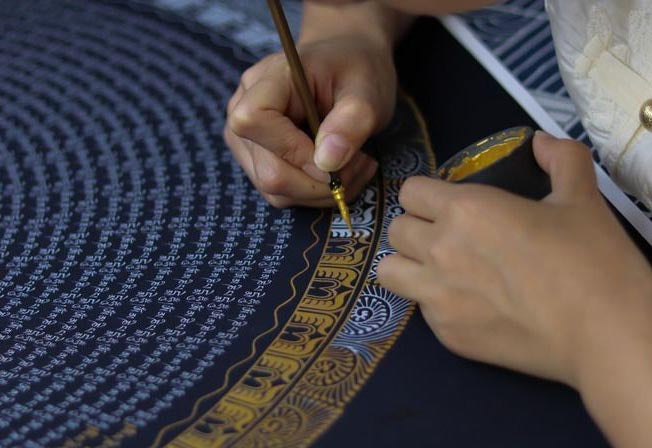
How Thangka Paintings Are Made
In the remote highlands of Tibet and parts of western China, an ancient artistic tradition continues to flourish with quiet determination. Known as thangka (or tangka), these scroll-style paintings are rich in intricate detail, natural pigments, and refined technique. Though often associated with cultural symbolism, thangka paintings also represent a unique form of craftsmanship—one that demands patience, precision, and a deep respect for traditional methods.
While a single painting may take weeks or even months to complete, the process of creating a thangka is as captivating as the final image itself. From raw materials to hand-mixed pigments and painstaking brushwork, thangka art embodies the essence of slow, intentional creation.
It All Begins with the Canvas and Pigments
Before any brush touches the surface, preparation of the canvas is essential. Thangka paintings are traditionally done on hand-woven cotton or silk. But this fabric must first be transformed. The surface is coated several times with a primer made from finely ground minerals and plant-based binders, then carefully polished by hand until it becomes smooth, durable, and capable of absorbing pigment without bleeding or cracking.
The pigments themselves are perhaps the most remarkable part of thangka-making. Artists rely on naturally sourced minerals like malachite, cinnabar, and lapis lazuli to produce vibrant hues of green, red, and deep blue. These minerals are ground into a fine powder and mixed with water and natural binders to form paint. Gold powder is often added for fine highlights and ornamentation, lending a soft sheen and layered texture to the final image.
What makes these colors extraordinary isn’t just their brilliance—it’s their endurance. Thangkas that are hundreds of years old still retain much of their original color and depth. This is the product of both natural materials and careful technique.
Drawing, Painting, and Layering by Hand
Every thangka begins with a line drawing. Artists sketch out the layout with a pencil or charcoal, following a set of traditional proportions. Each element—whether a landscape, a figure, or an abstract pattern—is placed according to precise structural rules. This stage can take days on its own, especially for complex compositions.
Once the draft is complete, layers of paint are applied gradually, starting with broad base tones and working toward finer details. Because natural pigments dry slowly and require a steady hand, this is a deeply methodical process. It demands long periods of focus, a familiarity with mineral paint behavior, and the ability to maintain consistent color and density across the canvas.
The true beauty of a thangka often lies in its fine detailing. Artists use extremely thin brushes to add texture to clothing, shadows to faces, and intricate patterns to backgrounds. Some areas—like ornamental borders or halos—are embellished with gold paint, giving the finished work a dimensional, luminous quality.
The entire process isn’t rushed. Depending on the size and complexity, a single thangka may require anywhere from 40 to over 200 hours of dedicated work.
Mounting the Thangka: Finishing with Purpose
When the painting itself is done, the thangka is mounted in the form of a hanging scroll. Silk brocade—often in deep reds, blues, and golds—is sewn around the painting as a border, giving it structure and elegance. A wood dowel is added to the top for hanging, and a heavier bar at the bottom helps keep the scroll flat.
This traditional mounting style is part of what makes thangka paintings unique. They're portable, can be rolled and stored safely, and when hung, they command presence—both artistically and aesthetically.
A Tradition of Time and Craft
There is something deeply human about the slowness of thangka-making. It resists automation. It favors the quiet over the immediate. Every step—grinding pigments, layering color, drawing steady lines—requires time, intention, and skill.
In a fast-paced world, thangkas stand as evidence of what happens when we slow down. They are not just objects of beauty but reflections of centuries-old discipline, patience, and heritage.
Though thangka art originated in a particular cultural context, its craftsmanship and visual elegance have captivated collectors, artists, and creators around the world. And increasingly, people are finding ways to connect with this art form in their own homes.
Tibet Echo: Bringing Thangka into Everyday Life
At Tibet Echo, we believe that traditional art shouldn't be locked behind museum glass—it should be experienced. That’s why we’ve collaborated directly with skilled artisans in Tibet to develop a series of DIY Thangka painting kits designed for hands-on creativity.
Each kit includes an original hand-sketched design by an experienced thangka artist, canvas prepared with traditional techniques, and mineral-based pigments carefully packaged for home use. These kits are not toys or simplified replicas—they are real, thoughtfully constructed introductions to the world of thangka art.
Whether you’re looking for a meditative creative project, an advanced DIY challenge, or a meaningful piece of décor that you bring to life yourself, our DIY kits offer an invitation into a world of precision, patience, and cultural beauty.
Depending on the size of the design, creating your own thangka may take several hours—or several dozen. But that’s the point. As your brush moves line by line, color by color, you’re not just making art. You’re making time for yourself.
If you’re interested in thangka, Tibetan culture, or simply the deeply rewarding process of mindful handcrafting, we invite you to explore our DIY Thangka collection at Tibet Echo.





